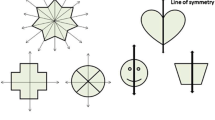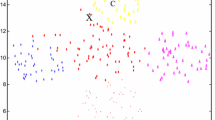Abstract
From a dataset automatically identifying possible count of clusters is an important task of unsupervised classification. To address this issue, in the current paper, we have focused on the symmetry property of any cluster. Point and line symmetry are two important attributes of data partitions. Here we have proposed line symmetry versions of eight well-known validity indices: XB, PBM, FCM, PS, FS, K, SV, and DB indices to make them capable of identifying the accurate count of partitions from data sets containing clusters having line symmetric property. The global optimality of two of these newly developed indices is established mathematically. Eight artificially generated data sets of varying dimensions containing clusters of different convexities and shapes and three real-life data sets are used for the purpose of experiment. Initially, to obtain different partitions an existing genetic clustering technique which uses line symmetry property (GALS clustering) is applied on data sets varying the count of clusters. queryPlease check and confirm the edit in the following sentence: We have also provided a comparative study of our proposed line-symmetry-based cluster validity indices with their point-symmetry-based versions and original versions based on Euclidean distance. We have also provided a comparative study of our proposed line-symmetry-based cluster validity indices with their point-symmetry-based versions and original versions based on Euclidean distance. From the experimental results it is revealed that most of the line-symmetry-distance-based cluster validity indices perform better than their point symmetry and Euclidean-distance-based versions.









Similar content being viewed by others
References
Attneave F (1995) Symmetry information and memory for pattern. J Psychol 68:209–222
Bandyopadhyay S, Maulik U (2001) Nonparametric genetic clustering: comparison of validity indices. IEEE Trans Syst Man Cybern C Appl Rev 31(1):120–125
Bandyopadhyay S, Saha S (2007) GAPS: a clustering method using a new point symmetry based distance measure. Pattern Recognit 40:3430–3451
Bandyopadhyay S, Saha S (2012) Unsupervised classification: similarity measures, classical and metaheuristic approaches, and applications, artificial intelligence. Springer, Berlin
Bezdek JC (1973) Fuzzy mathematics in pattern classification. Ph.D. thesis
Chou CH, Su MC, Lai E (2002) Symmetry as a new measure for cluster validity. In: Proc. 2nd WSEAS int. conf. sci. comput. softw. comput., pp 209–213
Chou CH, Hsieh YZ, Su MC (2014) A new measure of cluster validity using line symmetry. J Inf Sci Eng 30(2):443–461
Davies DL, Bouldin DW (1979) A cluster separation measure. IEEE Trans Pattern Anal Mach Intell PAMI-1(2):224–227
Dubes RC, Jain AK (1976) Clustering techniques: the users dilemma. Pattern Recognit 8:247–260
Dunn JC (1973) A fuzzy relative of the ISODATA process and its use in detecting compact well-separated clusters. J Cybern 3(3):32–57
Everitt BS, Landau S, Leese M (2001) Cluster analysis. Arnold, London
Fukuyama Y, Sugeno M (1989) A new method of choosing the number of clusters for the fuzzy c-means method. In: Proc. 5th fuzzy syst. symp., pp 247–250
Hruschka E et al (2009) A survey of evolutionary algorithms for clustering. IEEE Trans Syst Man Cybern C Appl Rev 39(2):133–155
Jolliffe I (1986) Principal component analysis. Springer Series in Statistics. Springer, England
Kim DJ, Park YW, Park DJ (2001) A novel validity index for determination of the optimal number of clusters. IEICE Trans Inf Syst D-E84(2):281–285
Kwon SH (1998) Cluster validity index for fuzzy clustering. Electron Lett 34(22):2176–2177
Liu Y, Ozyer T, Alhajj R, Barker K (2005) Integrating multi-objective genetic algorithm and validity analysis for locating and ranking alternative clustering. Informatica (Slovenia) 29(1):33–40
Maulik U (2008) Hierarchical pattern discovery in graphs. IEEE Trans Syst Man Cybern C Appl Rev 38(6):867–872
Pan SM, Cheng KS (2007) Evolution-based tabu search approach to automatic clustering. IEEE Trans Syst Man Cybern C Appl Rev 37(5):827–838
Saha S, Bandyopadhyay S (2009) Performance evaluation of some symmetry-based cluster validity indexes. IEEE Trans Syst Man Cybern Part C Appl Rev 39(4), 420–425
Saha S, Bandyopadhyay S (2011) On principle axis based line symmetry clustering techniques. Memetic Comput 3:129–144
Xie XL, Beni G (1991) A validity measure for fuzzy clustering. IEEE Trans Pattern Anal Mach Intell 13(8):841–847
Zakarian A (2008) A new nonbinary matrix clustering algorithm for development of system architectures. IEEE Trans Syst Man Cybern C Appl Rev 280(1):135–141
Author information
Authors and Affiliations
Corresponding author
Ethics declarations
Conflict of interest
The authors declare that they have no conflict of interest.
Additional information
Communicated by S. Deb, T. Hanne and S. Fong.
Rights and permissions
About this article
Cite this article
Acharya, S., Saha, S. & Bandyopadhyay, S. Use of line based symmetry for developing cluster validity indices. Soft Comput 20, 3461–3474 (2016). https://doi.org/10.1007/s00500-015-1848-5
Published:
Issue Date:
DOI: https://doi.org/10.1007/s00500-015-1848-5




